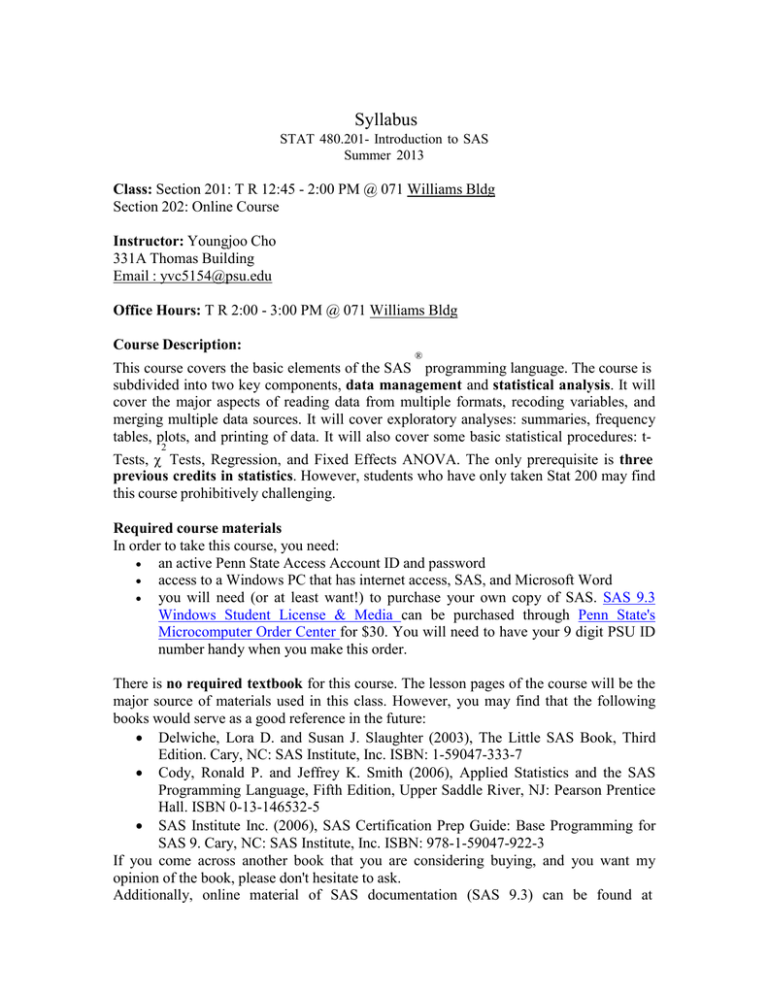
Syllabus
STAT 480.201- Introduction to SAS
Summer 2013
Class: Section 201: T R 12:45 - 2:00 PM @ 071 Williams Bldg
Section 202: Online Course
Instructor: Youngjoo Cho
331A Thomas Building
Email : yvc5154@psu.edu
Office Hours: T R 2:00 - 3:00 PM @ 071 Williams Bldg
Course Description:
®
This course covers the basic elements of the SAS programming language. The course is
subdivided into two key components, data management and statistical analysis. It will
cover the major aspects of reading data from multiple formats, recoding variables, and
merging multiple data sources. It will cover exploratory analyses: summaries, frequency
tables, plots, and printing of data. It will also cover some basic statistical procedures: t2
Tests, χ Tests, Regression, and Fixed Effects ANOVA. The only prerequisite is three
previous credits in statistics. However, students who have only taken Stat 200 may find
this course prohibitively challenging.
Required course materials
In order to take this course, you need:
an active Penn State Access Account ID and password
access to a Windows PC that has internet access, SAS, and Microsoft Word
you will need (or at least want!) to purchase your own copy of SAS. SAS 9.3
Windows Student License & Media can be purchased through Penn State's
Microcomputer Order Center for $30. You will need to have your 9 digit PSU ID
number handy when you make this order.
There is no required textbook for this course. The lesson pages of the course will be the
major source of materials used in this class. However, you may find that the following
books would serve as a good reference in the future:
Delwiche, Lora D. and Susan J. Slaughter (2003), The Little SAS Book, Third
Edition. Cary, NC: SAS Institute, Inc. ISBN: 1-59047-333-7
Cody, Ronald P. and Jeffrey K. Smith (2006), Applied Statistics and the SAS
Programming Language, Fifth Edition, Upper Saddle River, NJ: Pearson Prentice
Hall. ISBN 0-13-146532-5
SAS Institute Inc. (2006), SAS Certification Prep Guide: Base Programming for
SAS 9. Cary, NC: SAS Institute, Inc. ISBN: 978-1-59047-922-3
If you come across another book that you are considering buying, and you want my
opinion of the book, please don't hesitate to ask.
Additionally, online material of SAS documentation (SAS 9.3) can be found at
http://support.sas.com/documentation/onlinedoc/stat/ - stat93.
Tentative course schedule
Lecture 1 --- Introduction to SAS + enter data into SAS
Lecture 2 --- Entering and Exploring Data:
Lecture 3 --- Explore Data with Graphs:
Lecture 4 --- Manage Dataset
Lecture 5 --- T-Tests and Nonparametric Comparisons
Lecture 6 --- Merge SAS Data Sets
Lecture 7 --- Correlation and Simple Regression
Lecture 8 --- Regression Diagnostics (1)
Lecture 9 --- Regression Diagnostics (2)
Lecture 10 --- ANOVA
Lecture 11 --- Summary: Final Review and Q&A
Approximate Grading scheme
Midterm project : 25% (Due by July 19th 11:59:59pm)
Final project : 35 % (Due by August 9th 9:00am)
6 in-class quizzes : 15%
6 homework assignments : 25%
A
93%
A90%
B+
87%
B
83%
B80%
C+
77%
C
70%
C65%
D
60%
F
<60%
Homework and quiz policy : Late homework is not accepted unless there is reasonable
excuse. No makeup quiz is offered except reasonable excuse which you should tell me
before the quiz. Sharing of syntax files, solution files, and/or answer text is strictly
forbidden. You may work together on the homework to resolve bugs, but the whole of
your submissions must be completely written by you. Collaboration is not permitted on
the projects.
Course Web Site:
In ANGEL course management system, you should be automatically registered.
Please check the website frequently for course materials and announcements. Go to
http://cms.psu.edu and login using your PSU access account. Select Stat 480 from
the course list.
Academic Integrity Policy
All Penn State policies regarding ethics and honorable behavior apply to this course.
Academic integrity is the pursuit of scholarly activity free from fraud and deception
and is an educational objective of this institution. All University policies regarding
academic integrity apply to this course. Academic dishonesty includes, but is not
limited to, cheating, plagiarizing, fabricating of information or citations, facilitating
acts of academic dishonesty by others, having unauthorized possession of
examinations, submitting work of another person or work previously used without
informing the instructor, or tampering with the academic work of other students.
For any material or ideas obtained from other sources, such as the text or things you
see on the web, in the library, etc., a source reference must be given. Direct quotes
from any source must be identified as such.
All exam answers must be your own, and you must not provide any assistance to
other students during exams. Any instances of academic dishonesty WILL be
pursued under the University and Eberly College of Science regulations concerning
academic integrity. For more information on academic integrity, see Penn State's
statement on plagiarism and academic dishonesty.
Disabilities
It is Penn State's policy not to discriminate against qualified students with
documented disabilities in its educational programs. If you have a disability--‐related
need for modifications in this course, contact your instructor and the Office for
Disability Services (located in 116 Boucke Building). Instructors should be notified
as early in the semester as possible. You may refer to the Nondiscrimination Policy
in the Student Guide to University Policies and Rules 1997. See the website
http://www.equity.psu.edu/ods/ for details.



